Genesis HighSpeed Equipment for Electrical Testing at the Damstra Lab
The Prof. Ir. Damstra Laboratory in Hengelo—also known in short as the Damstra lab—is a laboratory for the testing of electrical components and systems. The lab carries out a wide range of electrical tests and is one of the few labs in the Netherlands with a generator for conducting short-circuit tests. The Damstra lab is an independently operating part of the Eaton group, which not only conducts tests for Eaton companies but also for other producers. Just like many other test centers in the low-, medium-, and high-voltage segments, the lab uses Genesis HighSpeed equipment for transient recording and data acquisition.
The Damstra lab performs various tests on electrical components and equipment. With the help of the tests, the lab validates the designs and specifications in the context of the product development of manufacturers, takes care of the certifications in accordance with the applicable standards, and checks the components that are generated from the production. This ensures that they meet the initial product specifications and that the production processes are in order. In addition, the lab conducts non-conformity research to determine the causes behind the failure of systems. In addition, the lab’s employees advise its clients on drawing up test plans in the context of design validation and product certification.
“The Damstra lab specializes in the testing of electrical switching and distribution systems and electrical switching components,” said Menno Visser, the laboratory manager. “Our core competence is translating the product standard into a reliable test. We test equipment ranging from fuses and high-voltage pantographs for railways to cable shoes and busbar systems. We carry out short-circuit tests, voltage impulse tests, voltage resistance tests, (partial) discharge measurements, temperature rise tests, and mechanical endurance tests. Our customers include panel builders, producers of cables and accessories, and companies that are engaged in utilities, energy and transport such as electric vehicles and rail transport.”
The lab works in accordance with IEC/ISO 17025 and is annually audited by the IECEE as CB Test Lab for DEKRA certification. In addition, the Damstra lab has been recognized by Intertek for the performance of ASTA certifications.
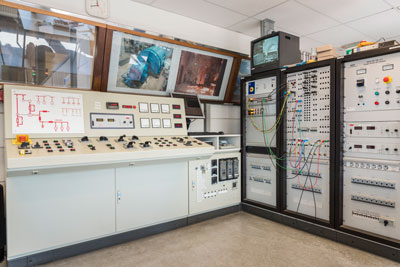
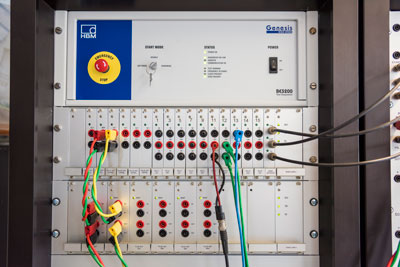
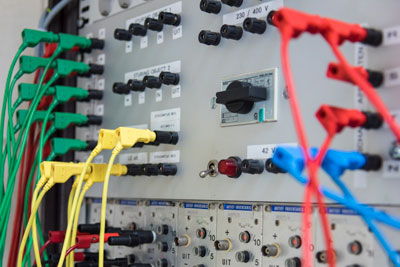
Hazemeyer and Holec
The history of the Damstra lab dates back to 1920 when Hazemeyer & Co set up its lab. During the early years, the lab was mainly involved in the testing of products that were developed and produced by Hazemeyer and, later, by Holec itself. The Damstra lab was one of the first labs in the Netherlands with facilities for high-voltage testing.
In 2001, a new laboratory was opened at the current location on the Europalaan in Hengelo, and it was named after Prof. Damstra, who was involved in the designing of the new lab. In 2003, Holec was taken over by Eaton. The lab is formally a part of Eaton’s European electrical division, but it acts as an independent test lab. As a result, the lab is also capable of carrying out work for third parties. Over the years, the work that the lab completes for third parties has increased considerably and, currently, it even comprises the majority of the assignments.
“With 12 employees, the Damstra lab is not the largest test lab for electrical components and systems,” explained Visser and added, “but because we are a relatively small and flat organization, we can operate flexibly and quickly. There is a lot of competition worldwide, but thanks to the short lines of communication, the effective test installations and the experienced engineers, we can optimally support our customers. We take care of the complete test cycle with our team. We develop the tests, configure the test setup, carry out the tests, validate the data, and record all results in a test report. In addition, we carry out the maintenance of the equipment ourselves.”
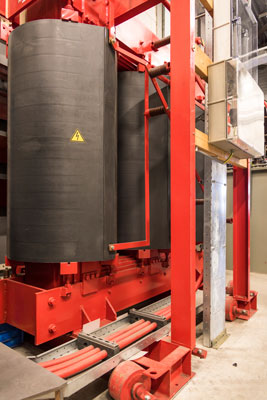
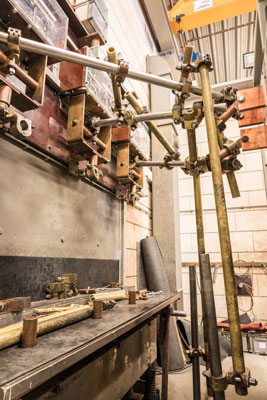
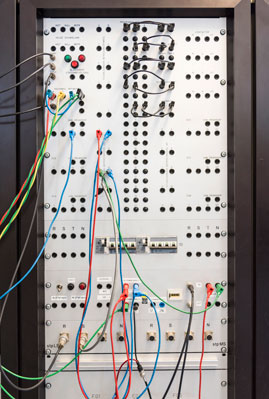
Well equipped facilities for electrical component testing
The Damstra lab is well equipped. “We have four test rooms where we carry out various types of short-circuit tests,” explained Peter van Gestel, the senior test engineer and coordinator of short circuit testing during a guided tour. “Two of the test rooms are linked to their own short-circuit generator, which dates from 1956, but which was radically revised in 2015. The rotor of the generator weighs 28 tons and delivers a power of 500 MVA. The output voltage of 6.3 kV is transformed to different voltage levels by means of transformers, whereby a maximum short-circuit current of 120 kA can be generated for one second. The switch-on system developed by us in combination with HBM timers allows us to carry out short-circuit tests in the low-voltage segment up to 1450 volts and in the medium voltage segment up to 24 kV. We also have an extensive dielectric lab with mains frequency tests, discharge tests, and shock test tests on low- and medium-voltage systems and components are carried out with voltages up to 400 kV.”
For temperature tests ranging from -40 to +180 degrees Celsius, four climate chambers for small components are present in the test laboratory along with a temperature chamber for large equipment and installations, in which temperature tests ranging from -25 to +60 degrees Celsius can be performed. In the lab, mechanical endurance tests can also be carried out on switches, for example, which can be recorded with high-speed cameras, if required.
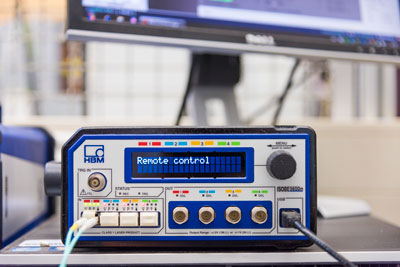
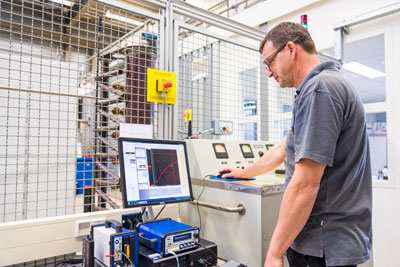
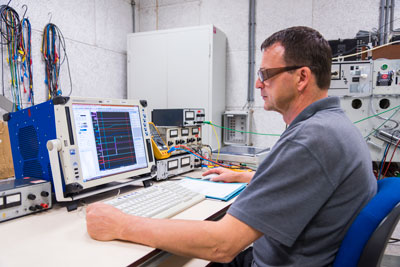
Lightning Tests
The lab has been using test and data acquisition equipment since the 1980’s, including the forerunners of Genesis HighSpeed hardware that have been produced by HBM since 2009. Today, various systems from this series are in use at the Damstra lab for the conduction of various tests, including the Genesis 7t, Genesis 5i, and Genesis 2i data acquisition systems. The Genesis equipment comprises a transient recorder, a data recorder, and data acquisition system in one housing. The lab also uses equipment from HBM, which has been specially developed for electrical testing. For example, the lab has an ISOBE5600, a standalone transient recorder, that measures at a speed of up to 100 MS/s. The recorder provides digital data and is ideally suited for performing high-voltage tests, such as lightning tests, switching tests, and pulse tests. The recorder is protected against electromagnetic interference by the use of fiber optic cables. The HBM Perception software ensures the processing of the measurement data.
“The advantages of a HBM transient recorder system are also reflected in the measurement of burst voltages,” said Van Gestel. “A lightning pulse lasts only a fraction of a second, so you have to measure at extremely high speeds. Because the transfer of the measurement data to the PC via fiber optic, interferences are excluded, making the measurement data more accurate. Because the transhipment of high voltage is impossible, safety also improves considerably.”
The Damstra lab also uses a BE3200 test sequencer from HBM. With this high-speed controller, the use of equipment for performing tests can be accurately controlled. The device has been specially developed for the timing and management of test sequences during the testing of switchgear in the low-, medium-, and high-voltage segments. A sensor is installed in the shaft of a short-circuit generator, synchronizing the timing of the sequencer with the generator. The 32 optically isolated outputs switch on and off according to a programed sequence. The software delivers the results in milliseconds. The program for the controlling sequencer runs on a normal PC.
Very satisfied with Genesis HighSpeed equipment
“We never really saw the need to orient ourselves on alternatives to Genesis HighSpeed equipment,” said Van Gestel.
“We are very satisfied with the equipment and the software. The equipment and the software are known in the industry as very reliable and have been validated. External audits of our labs are, therefore, very flexible with regard to measuring equipment and software. HBM supplies equipment and software and provides training and maintenance. We particularly like the automatic software updates as part of the service contract, because our software is always up-to-date on what equipment we use. It is important that the HBM consultants always actively think about the optimal solution. While we ourselves set the specifications for the measuring equipment we want, HBM always gives valuable advice on the final solution. HBM also supports us in programming the software if we need specific functionality. It is really a big advantage for us that the Genesis development department is located in Waalwijk, so the lines are very short. We are also regularly consulted by the development department when HBM is working on new developments. This results in a fruitful interaction”.